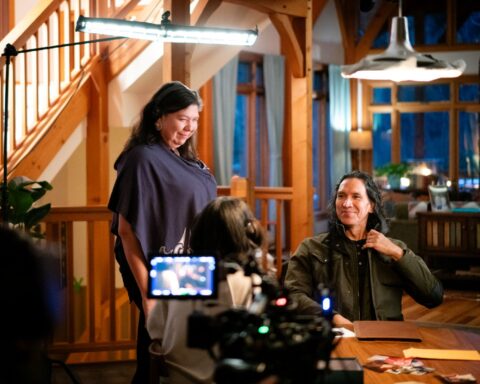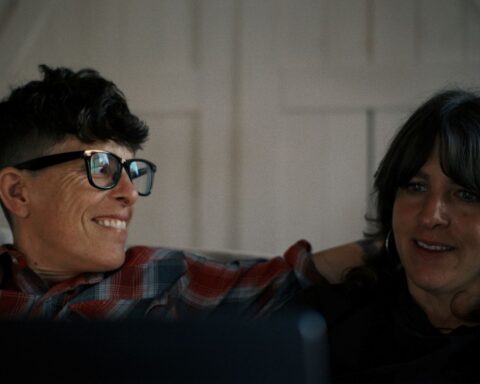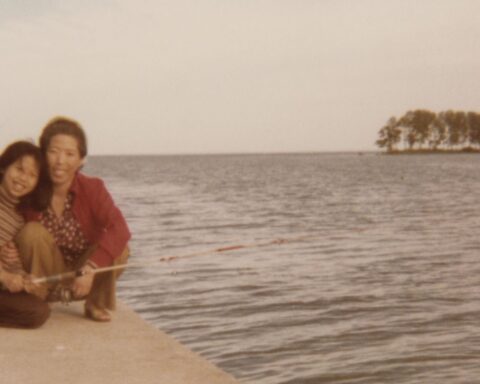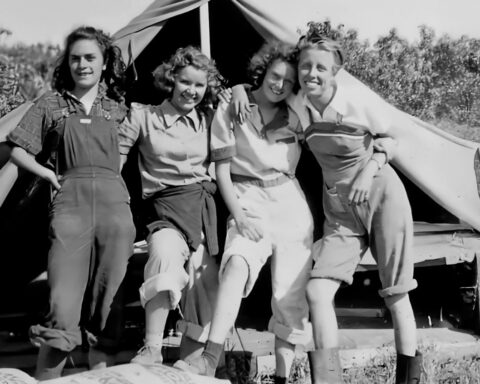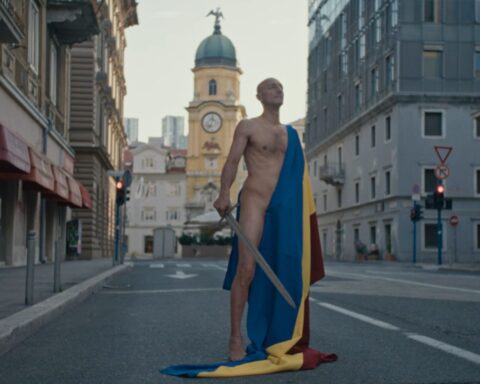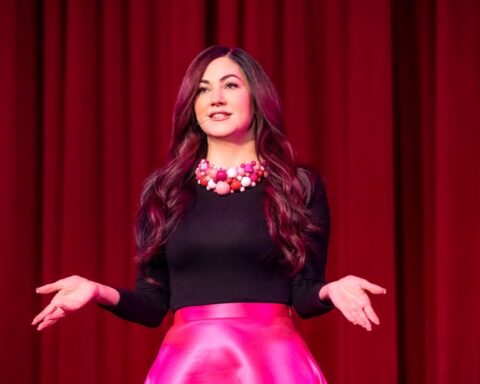Partners in life and work, the dynamic documentary filmmaking duo of Maya Gallus and Justine Pimlott have been film festival darlings for 10 years now—longer when their individual work is noted. For Gallus, it began over 20 years ago with her stellar first film, Elizabeth Smart: On the Side of the Angels. For Pimlott, who worked as a sound recordist on over 100 docs (some of the most memorable from the National Film Board’s now-defunct Studio D), it began in 2000 with her award-winning turn as director/writer and producer of Laugh In the Dark, a film that critic Thomas Waugh called “one of the most effective and affecting elegies in Canadian queer cinema.”
Together as Red Queen Productions, they have created a rich and diverse body of work, from straight-up vérité to hybrid documentary-drama, anchored in stories that humanize and bring into the mainstream often-derided or marginalized experiences. They’ve broken stereotypes and misconceptions about the choices women and LGBT people make in following their own passions: in art (Elizabeth Smart, The Mystery of Mazo de la Roche), in sport (Punch Like a Girl and the forthcoming Hot Rollers), as activists (Cat City and the forthcoming The Fruit Machine), in how we love (Fag Hags: Women Who Love Gay Men), how we live our gender and sexual identity (Erotica, Laugh in the Dark, Girl Inside), and how we make our living (Dish: Stories From The Frontlines of Waitressing). It’s work that’s garnered a passel of awards and international festival invitations for memorable characters and engrossing, openhearted stories told with humour, integrity, passion, beauty and, always, love.
In the swelter of a late summer afternoon, I sat down with Gallus and Pimlott in the front window seat of their modest, bright second-floor office, nestled in the heart of an ad hoc community of small doc production companies in downtown Toronto. In spite of the community vibe, the spectre of documentary’s collapse is all around. At the very least, it’s a moment when traditional partners and models of support have crumbled and fallen away, hopefully to make way for new ways of making films. Here, then, the Red Queens reveal the secret sauce to their success and nimbleness. Hint: it’s a classic combo of optimism and dogged determination.
(BC: Barri Cohen, for POV | JP: Justine Pimlott | MG: Maya Gallus)
BC: It’s your 10th anniversary as Red Queen Productions. Does it feel like 10 years?
JP: When I look at our filmography, I think, “Oh yeah, it’s been 10 years.” But you know what? I feel like we’re just hitting our stride. Athletes talk about “being in the zone,” and I feel like we’re finally “in the zone.”
BC: What’s “in the zone” right now?
MG: We are working on Hot Rollers [working title], a documentary about women’s roller derby.
JP: It’s looking at the subculture and the sport and how derby is changing into more of a serious sport.
MG: It’s still a subculture but moving away from camp into being more accepted.
JP: It’s revisiting some of the themes we looked at in [their series on women boxers – ed.] Punch Like a Girl, about women and aggression.
MG: And our other film at the moment is The Fruit Machine.
JP: I wanted to make a feature documentary about the early rise of the gay rights movement in Canada. I found a way through telling the story of The Body Politic, Canada’s paper of record for the gay community from 1971 to 1987. “The Fruit Machine” is the nickname of a machine the RCMP used in the ’50s and ’60s to try to purge alleged homosexuals from the military and the civil service.
MG: “The Fruit Machine” was a machine that tested heart rate and they’d show stimulating images. So the name—it’s a working title—is a metaphor to talk about a movement. It’s a way of framing the rise of the gay rights movement in Canada with the story of The Body Politic.
JP: This is our The Times of Harvey Milk, in the sense that it’s about a political movement, a revolution that started in ’71. The state and the right-wing media were huge in terms of constant oppression of the gay community. So, the fact that this small gay liberation paper became a voice for the community to fight back and win is a really powerful story.
BC: Where are you in funding it? What’s the budget?
JP: We work with really low budgets. Of course we’d like them to be higher. For The Fruit Machine we need a significant budget just for the archival costs alone.
MG: And our films look much more expensive than they are!
JP: I raised all the development funding in the community so far.
MG: We were lucky. We just received the Shaw Media Hot Docs Development Fund loan. We don’t have a broadcaster or anything attached to it yet, which is the way our passion projects sometimes start. You try to find some financing, somewhere. We just start shooting.
BC: How do you decide who does what? Is it driven by who has the most passion for the particular story?
MG: Basically one person takes the directing credit if it’s something they’ve wanted to work on for a long time. We always collaborate, but I directed The Mystery of Mazo de la Roche and Dish and Justine directed Cat City and Fag Hags. In this case, we’re co-directing, but one of us will take the lead, so Justine is driving The Fruit Machine and I’m driving Hot Rollers.
BC: How was Red Queen Productions formed?
MG: We just started working together. In hindsight, I don’t think it would work very well to start a personal relationship and then begin working together. We had already established a framework for a working relationship.
BC: That was on Erotica?
MG: Yes, I was making Erotica: A Journey Into Female Sexuality, and I wanted to have an all-female crew. I had Zoe Dirse on board as the DOP, and Zoe started campaigning for Justine [as sound recordist]. Justine phoned me one day and we just hit it off right away; she had the same sensibility, the same sense of humour. When we were shooting on location with Erotica, it was great for me because both Zoe and Justine had been trained by the NFB, so they weren’t just doing technical work, they were filmmakers too.
JP: Maya was clearly the director, but she allowed that space for me and Zoe to be able to bring our filmmaking creativity to the table. For example, we were filming a dominatrix in Erotica …
MG: …Madame Robbe-Grillet…
JP: …at her chateau in Normandy.
BC: A very memorable scene!
MG: And she wouldn’t let us into her chambre secret. Not when she was with her “supplicant.” So Justine asked, “Can we just record audio?” So we did, and it actually was cinematically much more interesting for me because so much about eroticism is in your imagination.
JP: Madame Robbe-Grillet went through her whole ritual, and we recorded it. Afterwards Zoe and Maya shot the visuals.
MG: I have to say it was fucking scary!
JP: Yeah, when we came out of that room, we were both like, okay, we’ve been in the trenches together and we were bonded forever!
MG: Then Justine was telling me that she was trying to make this film (her first) called Laugh in the Dark. We started talking about that, and I encouraged her. When we formed Red Queen Productions, it was for Punch Like a Girl. A friend of ours had said, “There’s a woman, Savoy Howe, who’s teaching at Sully’s Gym, do you want to try it?” So, we went. It was an incredible workout. At the end of that first class, Justine and I looked at each other and said, “This is a film.” We heard that the Life Channel, as Slice Network was called then, was looking for a limited series, so we re-imagined it as a series and did a demo and they loved it.
BC: And the influence for your name was, of course, the infamous Red Queen from Lewis Carroll’s Alice in Wonderland.
MG: I was always a big fan. There’s this powerful imagery around the Red Queen: the colour red, which is very passionate, intense. And the Queen, you know, woman, Amazon, queer. There were all these different threads that we just felt sounded right.
BC: There’s also a bit of mischief-making in the Red Queen as well, the connotation of disruption. Would you say that fits your work—that it educates, disrupts, shows new realities?
MG: It is very much…
JP: That’s what we do. Our films are about women, gender, sexuality; they’re about queer history, queer rights, arts and culture.
MG: They’re also about social and political communities on the margins.
BC: It seems to me that your films often create humane portraits of marginalized identities, and the actual struggle around identity, about finding one’s place in the world. Would that be a fair way to frame your work?
MG: Very much so. I think the overriding theme in most of my own personally driven films has been about being a woman and being an artist. I’m interested in figuring out gender within that identity. Justine has been focused more on social-political analysis, often looking at queer politics.
JP: Through personal stories, though.
BC: Certainly with Laugh in the Dark, and Fag Hags.
JP: Laugh in the Dark was a very personal film with people close to me that I lost to AIDS—and I was in the film, so I was the subject as well as the filmmaker. I’ve not done one of those since but Fag Hags was looking at similar issues—friendships between women and gay men but told through the stories of different couples and their personal relationships.
MG: Then Cat City, again, was personally driven.
BC: It too sketched humanity in the margins. Justine, what drew you to the cat-rescue community? Are you a cat lover?
JP: Yeah. I’m a stereotype.
MG: Justine’s a cat lover. But NOT a cat lady.
JP: Yeah, let’s distinguish that! One summer this abandoned cat came to live on our porch, and I discovered these animal rescue groups and that led me to an incredible world of volunteers who do amazing work rescuing cats and maintaining cat colonies all around Toronto. I was just so in awe of them. Sarah Jane Flynn [commissioning editor] at Global TV’s Global Currents was looking for one-offs. So I pitched it. Turned out that Cat City got really big numbers in terms of the whole strand.
BC: It’s about a community of people who are written off, pretty much. Fag Hags was also very much about profiling marginalized experience—in this case, about love between straight women and gay men.
MG: When we pitched Fag Hags at Banff [now World Media Festival] and won second prize…
JP: Thirty thousand dollars. Those were the good old days!
MG: When we pitched that, the perception of the film was largely that we were going to make this part sexy Will & Grace story and part pathologizing profile of the relationships.
JP: Yeah, Some the broadcasters were like, “What’s wrong with these people?” They wanted that angle.
MG: But that’s not how we approach our films. For us, these were actually profound stories and, in some cases, profound love stories.
JP: These subjects were actually inventing relationships. They were actually charting new territory.
MG: It was really about looking at what love is and the ways in which people can reinvent it. And that is one of the themes in a lot of our work, love.
BC: That’s very clear in your first film, Elizabeth Smart: On the Side of Angels.
JP: Absolutely. There, it is about obsessive love. [Ottawa-born writer Smart fell in love with British-born George Barker’s poetry—and him. They had a scandalous affair, resulting in four children, and Smart’s relocation to England for most of her life. – ed.]
MG: It’s also about a woman trying to be a writer and raise children and also who’s involved in this relationship with a poet. Her novel, By Grand Central Station I Sat Down And Wept, is about obsessive love. I think Elizabeth Smart was a pioneer in the sense of trying to be a writer at that time [1940s]. To me—and I only know these things in retrospect—I was trying to figure out how to be a writer, how to be an artist and a woman, and how to balance those things. So, with Elizabeth Smart, I was trying to understand how you can express yourself and put all of your passion into your work and your life and how the two can feed each other within that identity. Some people saw Smart’s life as this pathetic tragedy, others saw her as a romantic heroine. I was just really interested in her very human struggle as an artist. That theme, again, came up with _The Mystery
of Mazo de la Roche_.
BC: Another figure that, while she was very well known in her time, was obscure by today’s standards, and carved out a unique path as a woman and an artist.
JP: “ Canada’s most famous unknown writer.”
BC: With Elizabeth Smart, the form was really pushed. How did that come to be?
MG: Well, the reason I was able to break form was because I didn’t know anything. It was my first film. My interest was dramatic filmmaking. So I thought, “Okay, I’m going to approach this as a drama, so I hired Miroslaw Baszak, who shot Roadkill and Highway 61; I wanted someone who had a cinematic approach. I hired John Kramer because he had edited Under the Volcano [Donald Brittain’s biodoc about Malcolm Lowry], which I loved. And I approached Jackie Burroughs, who was amazing to work with, very powerful, to portray Smart.
BC: And Michael Ondaatje.
MG: Then I asked Michael Ondaatje to narrate it. I don’t have any qualms about just asking someone to get involved with something. And I just assumed they’d say yes, you know, “Come on board.”
BC: And you return to this hybrid approach with Mazo De La Roche. Why?
MG: After I made Elizabeth Smart, I went to the Canadian Film Centre as a director-writer. Around that time, I saw 32 Short Films about Glenn Gould, and I loved the way that they pushed the form [between docs and drama] even further. I remember thinking, “I’d like to do that with a film. Who could I do that with who is Canadian?” Then I remembered that I had clipped this little article about writer Mazo de la Roche and her relationship with her long-time companion [Caroline Clement]. [Mazo de la Roche’s series of novels The Whiteoaks of Jalna sold over 11 million copies. – ed.] So, I actually started working on it in the early ’90s, and I kept hitting obstacles. She was very difficult to decipher and it took me a long time to be able to understand what the key was to telling that story.
BC: Which was…
MG: Finally the way in was through her work, her alter ego, the character Finch Whiteoak and his coded homosexuality. Ultimately, I realized this was a film about love—Mazo and her companion, Caroline, as soul mates. Everything in her life and work was obscured but if you read between the lines it was all there.
BC: Hence your title, The Mystery.
MG: Then we revived it in 2000. So, I looked at my notes. It was going to be a documentary, then it was going to be a drama, and then it was going to be a documentary, and it kept going on like that.
JP: Then Anita Lee at the NFB in 2009 and Charlotte Engel at Bravo [2008] came in for development. Bless them!
BC: Is timing 9/10ths of the law?
JP: Yes. that’s why you don’t give up! Don’t just let a project die if you’re passionate about it, because it is very much about timing. Adrienne Rich has a poem called A Wild Patience has Taken Me This Far, and that’s how I feel about what we do. It’s the “wild patience” that you need.
MG: I was at the height of production for Dish, and Charlotte Engel called us. She said, “Okay, we’re on board for production.” And, I said, “Oh, great.” But I didn’t really take it in. She said, “This means you have to deliver next year. It’s now or nothing, because next year is a whole new ball game” [CTV was in the process of purchasing Bravo – ed.]. Everything was changing. And then we realized, “Oh shit! Now we have to pull together the rest of the financing in two months to meet the CTF [Canadian Television Fund] deadline!”
BC: If you were to try to get this film done today, 2013, what would happen?
JP: We wouldn’t be able to go anywhere.
BC: Why?
JP: Because, goodbye Bravo for arts programming.
MG: And CBC would never fund a film like that.
JP: And TVO isn’t commissioning these types of arts documentaries now, although they did come on as a second window. So this film wouldn’t be made now. Arts programming is gone. I don’t believe that if we pitched this film that we would get this film funded.
MG: Mazo de la Roche and the Film Board [were] a natural fit.
JP: And not just in terms of subject matter. They also support the filmmaker. They support those who are trying to push the form. And our co-producer there, Anita Lee, really championed what we were trying to do.
BC: Justine, how did you end up training at the NFB in the first place?
JP: I was living in Winnipeg and finishing university, studying sociology and I was a huge fan of cinema. I loved Margarethe von Trotta and all those early-’70s female film directors—Chantal Akerman, all of the gals. The local art house cinema in Winnipeg was great, but they rarely showed female filmmakers.
So I decided that I was going to organize a women’s film festival. I raised all of the money through the Women’s Caucuses of Trade Unions and other women’s groups. I held it at the NFB on Main Street in downtown Winnipeg. It was packed every night.
Chesley Yetman, who was the NFB executive producer in Winnipeg, took note of me and my passion, and asked me to do the publicity for two Studio D films [Behind the Veil and Bonnie Klein’s film Speaking our Peace] because my outreach had been so successful. He had heard about a training programme at Studio D and said to me, “Justine, they’re fields. You should apply for this. You’ll be able to move on to become a filmmaker.”
So I applied, and got it. I remember the day I got the letter. I just thought, “My life is about to change.” They gave us a salary and found us housing. Can you imagine?? They gave us housing! I was plunked into Studio D, into this place…you would walk into the cafeteria, and Denys Arcand would be sitting there, and Léa Pool, Donald Brittain. It was such a rich time. Steenbecks were available at all hours. You’d bring a six-pack of beer to pay off the security guard to let you in. It was extraordinary.
BC: It’s a great example of political, cultural will. That if you have a clear policy and act on it, great things can happen.
JP: It worked. Eighty percent of the women in that programme are working in cinema and television today.
BC: What in your background inspired your moxie in pulling that festival off, and indeed, in being a tireless, patient producer?
JP: My parents. I was born with moxie.
MG: Justine is a fearless Amazon. She was a red diaper baby.
JP: I was an orange diaper baby! My mother was a feminist, my father was a social democrat. I knew how to organize. My parents taught me. Makes good skills for being a producer!
*BC: You’re great at outreach. I notice you were an early adopter of social media to promote, for instance, Cat City.
JP: I’m constantly on Facebook promoting our work.
MG: Social media—Justine is totally all over that. She’s is very good at banging the drum and saying, “Hey, this is happening now.” I’m not so good at self-promotion. I’m a good cheerleader, if it’s about somebody else. I come in more in the first stage. I’m really good at hitting up the broadcasters and really talking up what we want to do.
BC: The pitch. Does it excite you?
MG: For me the pitch is a conversation. You talk about the story while trying to get a handle on what the broadcaster is thinking, so there’s a dialogue.
We do take “no” for an answer; we’ve been rejected many times. Yet there’s this perception that we’re lucky and we get everything we want, that we’re somehow the ‘documentary darlings.’
JP: It’s that we’re persistent. We don’t give up.
MG: We do get turned down, but then we come back or they come around. That’s the key. Girl Inside was a perfect example of that. I approached Rudy Buttignol [the then] commissioning programmer at TVOntario’s “View from Here” strand. He came in for development, but then, when it came to production, he said “no.” We had started shooting, and I didn’t know what to do. We were getting turned down everywhere. It was a dark time.
JP: But we just kept going, though, because we were following Madison’s story [she was transitioning from male to female] over several years. So we were committed.
MG: Then Rudy [Buttignol] called me sometime later, out of the blue, and said, “I’ve been pitched a couple of projects on similar themes. I actually think what you’re doing is more interesting. So, I am ‘in’”.
BC: Many filmmakers and producers have the view that if they get a “no”, you don’t burn your bridge by pestering again. It’s seen as a risky thing to do.
JP: But you go back because, especially with commissioners like Rudy Buttignol, it’s a process. What broadcasters want changes over time. We went on to be nominated for the Donald Brittain Award for Girl Inside and Maya won the Gemini for Best Direction. So it was right to pester!
MG: If there’s one thing I’ve learned in this business it’s that you have to get your ego out of the way. You have to get your ego out of the way anyway as a filmmaker, to tell other people’s stories. And in funding, you have to get your ego out of the way too. If somebody says “no,” even though it feels personal, you have to let it go. Then, you rethink, “Okay, where else can I go?” You just have to keep going.
JP: It helps that commissioning editors like Rudy are interested in the filmmaker. Not just what the film is about.
BC: If I didn’t know Maya directed Girl Inside, I’d say it’s…
JP: A ‘Justine’ topic?
BC: Yes. So, how did the relationship with Madison come together?
MG: A friend who works with queer youth had asked me to mentor a 17-year-old person transitioning from male to female. Originally, I was interested in telling her story and then shied away from that.
JP: Well, you didn’t pursue it because of the respect for your mentee/mentor relationship with her.
MG: But I realized that there was something really interesting there that people could learn from. There was a lot of exploitative stuff that pathologizes transitioning, and I wanted to combat that.
So I started going to these trans-youth group meetings, and I was very upfront. I said, “I’m interested in making a film and talking with anybody about your experiences.” Madison was there, and she said, “Sure, I’ll talk with you.” Right away, I said to her, “I want to talk to you, but you’re too old [she was 25] for what I’m looking for, for a film.” I said, “I really want to show someone who is much younger and how complicated that [transition] is.” She started talking, and when she told me about her grandmother, I had a gut feeling. So I went and met with Madison and her 80-year-old grandmother. I loved Vivien and Madison.
BC: Madison’s a terrific subject—forthcoming, strong and vulnerable at once. We care about her. And her grandmother Vivien was amazing.
MG: Vivien was larger-than-life. And Madison was so articulate and lovely. So then I said to her, “Actually, I think, this would be really interesting.” Our process of raising the finances coincided with her process of raising financing for her transition. So, we just kept shooting with her. There was a point where it was getting really hard for her. It’s hard to be followed and constantly being asked nosey questions. I said, “Madison, are you sure you still want to do this?” She said, “Yes. I am committed. I can’t say everyone else will.” But, her family proved to be extraordinary and Cameron, her boyfriend, was extraordinary. I think because they saw that the story we wanted to tell was not exploitative. We wanted also to tell a story about how the loved ones around the transitioning person also have to go through a transformation.
BC: There is a feeling of loss felt by the family members. That was palpable.
JP: That was really important, because what we were seeing in the more exploitative stuff is that people transitioning have no community.
MG: Which can be true, but I was interested in the fact that here was an example of someone who hadn’t been rejected by her family. And it was amazing to watch the grandmother taking Madison’s hand and trying to teach her about being a woman and about femininity.
BC: Is that what fascinated you?
MG: Yeah, I was intrigued with “old school” identity, what it means to be a woman versus new school, and that Madison had enough confidence as a person to reject it. She said, “That’s not who I am, but that doesn’t mean I’m not a woman, but I’m not interested in that.” It was comical, too, when Vivien tries to give Madison a makeover.
BC: You use different approaches with your films. Cat City is very intimate, vérité and gritty. Girl Inside evokes a different kind of intimacy, and Mazo is a lush, larger canvas of artifice and doc hybridity. At what point do you decide on your approach?
JP: Early on. I mean, certainly with Mazo very much.
MG: I had scripted Mazo. We shot the drama before we did the documentary, which I wouldn’t advise for someone approaching hybrid unless you are really clear with the material.
BC: I’ve done dramatic re-creations, as we call them, but I would never do that!
MG: But I knew this story so well. I had already written many different variations so it was quite scripted, and aesthetically, we knew that we wanted it to have a real period look, it was quite a fetish for me, to get that look with the wardrobe and the sets.
JP: What informed that approach too is that there wasn’t any footage of Mazo. No footage except a teensy little clip of her at the end at a Writer’s Trust dinner. There were photographs. Otherwise, nothing. Creatively that really informed the aesthetic.
MG: That was the same thing with Elizabeth Smart. And [editor] Roslyn Kalloo was an important part of it, because it was really important for us to work with an editor who understood drama and dramatic structure, which she understands beautifully.
BC: And how would you describe Dish’s style or aesthetic approach?
JP: Vérité.
BC: Almost anthropologically so at times, too.
MG: Anthropological, sociological, definitely. It’s vérité structured around specific themes. Initially I wanted to make a film about waitresses, because I had been a waitress, and I knew there was a particular perspective and experience of being a woman in the service industry.
BC: And with Fruit Machine, is it a bit of a departure for Justine? It’s more historical, which has typically been Maya’s territory. Will it be a quintessential “Red Queen” film?
MG: What is interesting about The Fruit Machine is it’s a real merging of our sensibilities, if you like, in the sense that I’ve tended to—I think I naturally gravitate towards making biographies, because I really like to get into the story of a person. I do a lot of research. I was trained as a journalist. In this case, this is a biography, but it’s a biography of a community, of a movement, of a time. It’s bringing our talents and sensibilities together in an interesting way.
JP: We’re co-directing it, for sure.
MG: But Justine is driving it.
JP: I think of all of our films, the ones that I feel best represent Red Queen are Girl Inside and Mazo. That’s what we do. A film like Girl Inside is a personal vérité documentary over a period of time; an intimate story with a subject. Then there’s Mazo, which does it on a much bigger scale.
BC: What do you love about documentary? Why do you do it?
MG: I fell into it. I was interested in journalism but my love was fiction filmmaking. So, I’ve always tried to bring a fictional film sensibility to what I do in documentary. I think we both try to bring that to a degree. That’s always been really important: bringing a fiction film/dramatic film aesthetic or structure to the social issue work of the documentary.
JP: For me, it is also about educating. It is about shedding light on subject matter. I feel that making documentaries is really connected to the way that I was raised. I feel that it’s the art form that I’ve chosen to try to help create social change. That’s really the bottom line.
MG: The most important thing to me, as a filmmaker, is my relationship with my subjects. You have to go in with an open heart and an open mind, but really an open heart. And my hope is that then the viewer will have their heart opened by the film.




